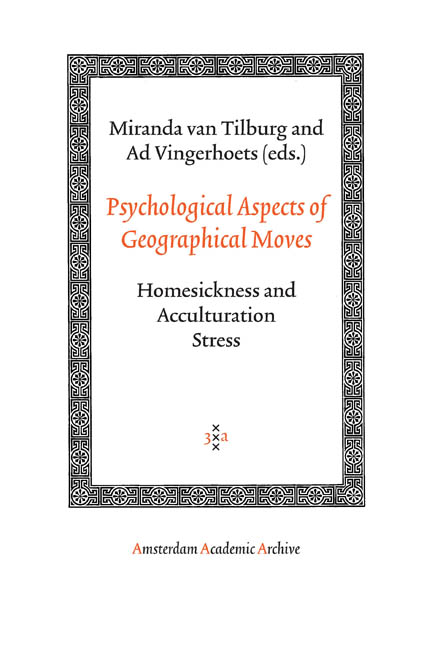Book contents
- Frontmatter
- Preface
- Contents
- Contributors
- 1 The Homesickness Concept: Questions and Doubts
- 2 Culture Shock, Homesickness, and Adaptation to a Foreign Culture
- 3 The Psychological Context of Homesickness
- 4 Geographical Moves and Psychological Adjustment
- 5 Homesickness and Acculturation Stress in the International Student
- 6 Psychological and Psychosocial Adjustment of Migrants: Families in a Changing Environment
- 7 Individual Differences in Acculturative Stress Reactions: Determinants of Homesickness and Psychosocial Maladjustment
- 8 The Cry for the Lost Placenta: Cultural Bereavement and Cultural Survival among Cambodians who Resettled, were Repatriated, or Stayed at Home
- 9 Children's Coping with Homesickness: Phenomenology and Intervention
- 10 Homesickness after Relocation during Early Adolescence
- 11 Personality, Temperament, and Homesickness
- 12 Homesickness, Personality and Personality Disorders: An Overview and Therapeutic Considerations
- 13 Health Issues in International Tourism: The Role of Health Behavior, Stress and Adaptation
- 14 Development of Psychopathology in International Tourists
- Miscellaneous Endmatter
8 - The Cry for the Lost Placenta: Cultural Bereavement and Cultural Survival among Cambodians who Resettled, were Repatriated, or Stayed at Home
Published online by Cambridge University Press: 23 January 2021
- Frontmatter
- Preface
- Contents
- Contributors
- 1 The Homesickness Concept: Questions and Doubts
- 2 Culture Shock, Homesickness, and Adaptation to a Foreign Culture
- 3 The Psychological Context of Homesickness
- 4 Geographical Moves and Psychological Adjustment
- 5 Homesickness and Acculturation Stress in the International Student
- 6 Psychological and Psychosocial Adjustment of Migrants: Families in a Changing Environment
- 7 Individual Differences in Acculturative Stress Reactions: Determinants of Homesickness and Psychosocial Maladjustment
- 8 The Cry for the Lost Placenta: Cultural Bereavement and Cultural Survival among Cambodians who Resettled, were Repatriated, or Stayed at Home
- 9 Children's Coping with Homesickness: Phenomenology and Intervention
- 10 Homesickness after Relocation during Early Adolescence
- 11 Personality, Temperament, and Homesickness
- 12 Homesickness, Personality and Personality Disorders: An Overview and Therapeutic Considerations
- 13 Health Issues in International Tourism: The Role of Health Behavior, Stress and Adaptation
- 14 Development of Psychopathology in International Tourists
- Miscellaneous Endmatter
Summary
Introduction
In this chapter I consider five themes fundamental to the plight of displaced persons world-wide: (1) cultural bonds to home and community; (2) the role of tradition in sustaining the cultural bonding and hence well-being of refugees; (3) the notion of cultural bereavement and how it may be worsened when culture is threatened; (4) how indigenous traditions need to be preserved in the face of intrusion of Western cultural paradigms; (5) the importance of cultural, as well as psychic, losses of displaced persons in their attempts to cope with movements from homeland, and with going home. These five themes will be illustrated by the case of Cambodian refugees.
"In a new twist to the use of homesickness, a captured Khmer Rouge soldier reported that three Western hostages held in captivity by the Khmer Rouge were getting progressively thinner. In his opinion, their weight loss was caused by homesickness, despite their being well fed by the general who held them captive and who, eventually, murdered them” (Sokhet, 1994).
Cultural bonding to place of birth
The cry for the lost placenta
The instant that a Cambodian baby is born, it undergoes a separation from its previous life, and becomes locked in a bond with the place of birth when, according to tradition, its parents bury the placenta nearby, in the prescribed direction. The burial site (the placenta is sometimes burned) is covered with cactus or spiny plants, to protect it from interference by dogs or by spirits. The location is critical, according to the traditional healers, who explain that the placenta is the ‘globe of the origin of the soul’ of the child. People fear that a violation of this code may cause harm to the mother, or to the baby. A blood-hungry spirit may eat the placenta and attack the mother, who may develop a mental disorder for the rest of her life. If the placenta is safe, so is the child – provided it does not stray too far. If the placenta is disturbed, so is the child, who may develop an illness, known as of the preceding mother’ (Eisenbruch, 1992). The ritual of burying the placenta is widely practiced in Southeast- Asia (Laderman, 1983), and it gives expression to the local belief that a person is safe at home and enters a state of danger on journeying from it (see Ewing, 1960; Geertz, 1960; and Laderman, 1983).
- Type
- Chapter
- Information
- Psychological Aspects of Geographical MovesHomesickness and Acculturation Stress, pp. 105 - 126Publisher: Amsterdam University PressPrint publication year: 2006



